Abstract
Transgenic tobacco plants that express an oat phytochrome gene (phyA) under control of the cauliflower mosaic virus (CaMV) 35S promoter and display altered photophysiology were used to test the role of light as a vehicle of information in dominance relationships between neighboring plants. Compared with the isogenic wild type, phyA-overexpressing plants showed dramatically reduced morphological responsivity to changes in the red/far red ratio of the incident light and to the proximity of neighboring plants in spacing experiments. In transgenic canopies an increase in stand density caused the small plants of the population to be rapidly suppressed by their neighbors. In wild-type canopies, plants responded to increased density with large morphological changes, and there appeared to be an inverse relationship between the magnitude of this morphological response and the ranking of the individual plant in the population size hierarchy. In these wild-type populations, size inequality increased only moderately with density within the time frame of the experiments. Our results suggest that, in crowded stands, the ability of individual plants to acquire information about their light environment via phytochrome plays a central role in driving architectural changes that, at the population level, delay the development of size differences between neighbors.
Full text
PDF




Selected References
These references are in PubMed. This may not be the complete list of references from this article.
- Ballaré C. L., Scopel A. L., Radosevich S. R., Kendrick R. E. Phytochrome-mediated phototropism in de-etiolated seedlings : occurrence and ecological significance. Plant Physiol. 1992 Sep;100(1):170–177. doi: 10.1104/pp.100.1.170. [DOI] [PMC free article] [PubMed] [Google Scholar]
- Ballaré C. L., Scopel A. L., Sánchez R. A. Far-red radiation reflected from adjacent leaves: an early signal of competition in plant canopies. Science. 1990 Jan 19;247(4940):329–332. doi: 10.1126/science.247.4940.329. [DOI] [PubMed] [Google Scholar]
- Bradford M. M. A rapid and sensitive method for the quantitation of microgram quantities of protein utilizing the principle of protein-dye binding. Anal Biochem. 1976 May 7;72:248–254. doi: 10.1006/abio.1976.9999. [DOI] [PubMed] [Google Scholar]
- Cherry J. R., Hershey H. P., Vierstra R. D. Characterization of Tobacco Expressing Functional Oat Phytochrome : Domains Responsible for the Rapid Degradation of Pfr Are Conserved between Monocots and Dicots. Plant Physiol. 1991 Jul;96(3):775–785. doi: 10.1104/pp.96.3.775. [DOI] [PMC free article] [PubMed] [Google Scholar]


